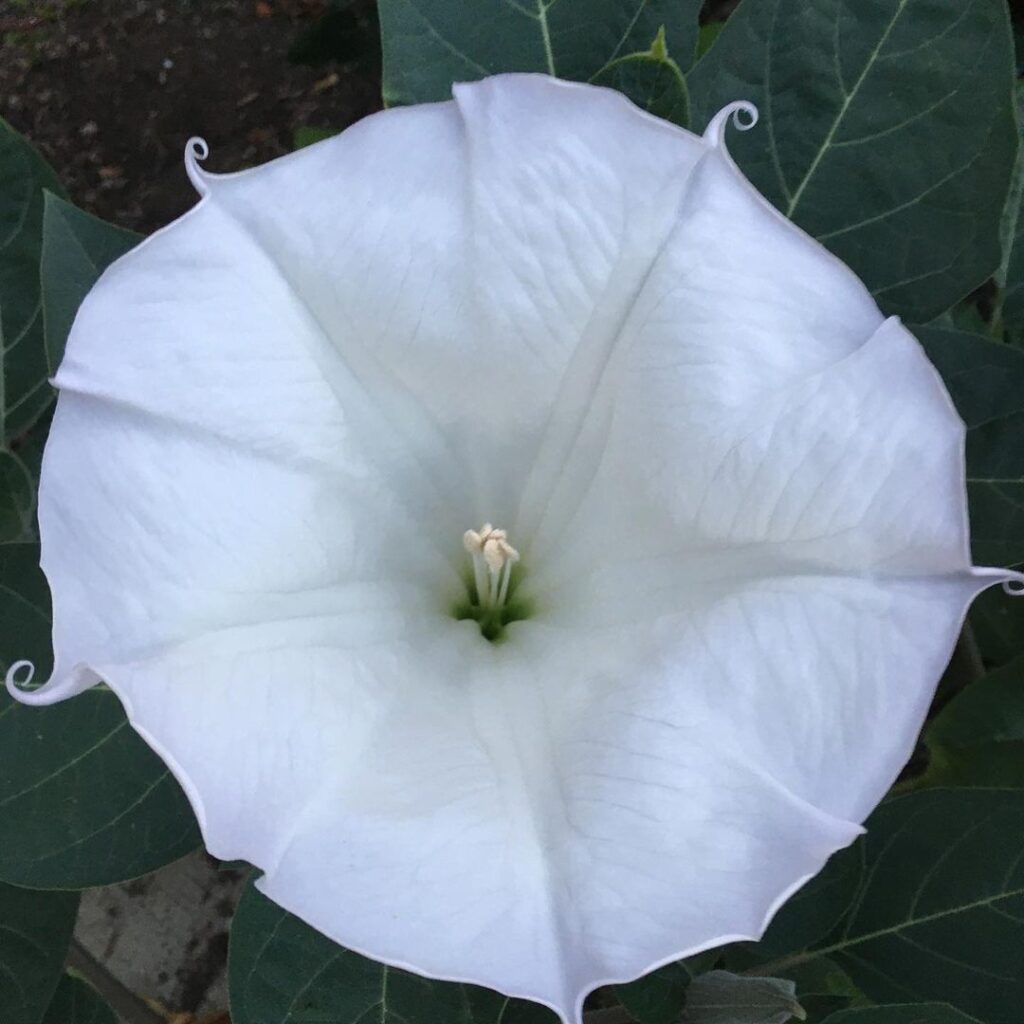Learn How to Grow Moon Lilies with our expert tips for planting, but also understand the potential risks before adding them to your garden.
Looking to add a striking perennial to your garden or landscaping? Learn How to Grow Moon Lilies, a beautiful flowering plant with minimal needs.
Common Names: Moon Lily, Jimsonweed, Sacred Datura, Thorn Apple, Angel’s Trumpet
Botanical Name: Datura wrightii
USDA Zones: 9-11
Note: This article belongs to the moonflower plant (Datura), which should not be confused with the moonflower vine (Ipomoea alba) despite sharing the same name.
Read: Thunbergia Erecta Clockvine Care
What Are Moon Lilies?
Moon lilies (Datura wrightii) are popular for the pale radiance of their blooms, which are distinctive among native wildflowers. These plants originate from the southwestern region of the United States and northern Mexico. They belong to the Nightshade family
This sprawling plant can grow up to 6 feet wide and 2-5 feet tall, producing fragrant large trumpet-shaped white flowers that are pollinated by moths and only bloom in the evening. While admired for its showy flowers, it is considered a weed in some parts of the West.
Also, these plants are highly toxic, posing a potential hazard in areas where children and pets frequent. They are ideal for low-maintenance landscaping using native species.
Read: Types of Bird of Paradise Varieties
Where to Plant Moon Lilies
Moon lilies can be planted in USDA Hardiness Zones 3-9. They are ideal for potting near porch swings to enjoy their evening fragrance.
However, since it can be an aggressive spreader, it’s important to pick off the seed pods to prevent it from taking over a garden.
Note: Additionally, if you have pets or small children, make sure to place the moonflower out of reach.
When to Plant Moon Lilies
As Moonflowers are susceptible to frost damage, it is advisable to wait until the last frost date in the spring before planting these tender plants in the ground or in containers outdoors.
Read: Balinese Plants and Flowers
How to Grow Moon Lilies
After the white blooms wither, thorny pods appear. These pods start off soft but grow harder and sharper with age. Once they dry on the plant, the pods can be opened to collect seeds, which can be sown in the fall in well-draining soil.
Read: Weeds with Purple Flowers
Ideal Growing Conditions for Moon Lilies
Light
Moon lilies prefer full sun (6 or more hours of direct sunlight a day) or partial shade (2-6 hours of direct sunlight). For optimal growth, provide a southern exposure with bright sun and ample warmth. However, in hotter areas, it may be beneficial to protect the plant from harsh afternoon sunlight.
Soil
Use well-draining soil with a neutral pH for growing this herbaceous perennial.
Water
Water moon lilies regularly, but avoid letting the soil become waterlogged. During the summer, water deeply every two weeks to promote lush foliage and abundant flowers. However, during winter, refrain from watering as natural rainfall should suffice.
Read: Queen of the Night Tulip Care
Moon Lilies Care
Fertilizer
It is not necessary to use fertilizer for datura, but you can apply a layer of compost or mulch around the base of the plant to maintain soil quality and prevent weed growth.
Pruning
Although not essential, pruning during the dormant season (late fall or winter) can help control the size of the plant.
Pests and Diseases
Moon lilies are resistant to insects, diseases, other issues, and deer damage.
Read: Night Blooming Jasmine Care
Landscaping Use of Moon Lilies
Moon lilies are a beautiful and low-maintenance addition to any garden or landscaping, especially in warm climates.
While their large size and sprawling growth can overcrowd smaller plants, they thrive in sunny perennial beds and borders.
In colder regions, this plant can be grown in containers, which makes it easier to manage their growth and overwinter them indoors.
When growing moonflowers in pots, make sure to use containers with drainage holes for optimal health.
Are Moon Lilies Toxic?
All parts of the plant contain highly poisonous alkaloids like scopolamine, atropine, and hyoscyamine. Even small amounts of ingestion or inhalation can lead to severe symptoms, including paralysis, increased heart rate, and even death. Those who survive moon lily poisoning may experience permanent organ damage and mental impairment.
Therefore, this plant may not be a suitable choice for ornamental plants where pets and children are present.
Note: Another potential disadvantage of moonflowers is their tendency to self-seed. Removing the spent flowers after blooming can prevent seed production and promote a more extended and abundant flowering period.




